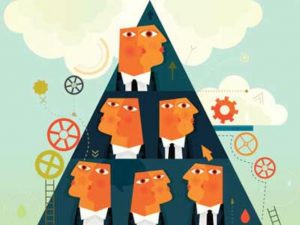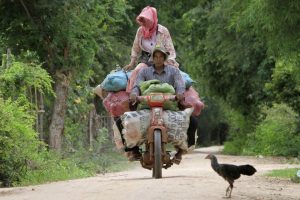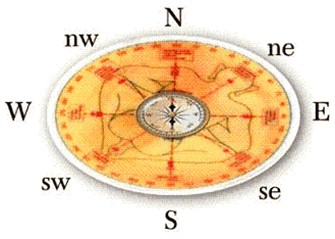The Bottom of Pyramid (BOP) is a socio-economic concept that allows us to group a vast segment of about four billion people who are the world’s poorest citizens. Though they consume products and services, they are invisible and are hardly served by the marketers because of the challenging barriers. The barriers are illiteracy, lack of stable living, hunger, and of course negligible earning. These poor consumers are unaware of their own human potential. They live on less than $2.50 a day.
The concept “Bottom of the Pyramid” (BoP) was first used by U.S. President Franklin D. Roosevelt in 1932 on an occasion when he was talking about the poor people who are often forgotten because they live at the bottom of the economic pyramid. Bottom of the pyramid (BOP), also called base of the pyramid, term in economics that refers to the poorest two-thirds of the economic human pyramid. Management scholar C.K.Prahalad popularised the idea of this demographic segment as a profitable consumer base in his 2004 book “The fortune at the bottom of the pyramid” co-authored by Stuart Hart. Prahalad wrote with unusual insight about consumer needs in poor societies and opportunities for the private sector to serve important public purposes while enhancing its own bottom line.
In his book, Prahalad challenged readers to re-evaluate their pre-conceived notions about the commercial opportunities in serving the relatively poor nations of the world. The Bottom of the Pyramid highlights the way to commercial success and societal improvement-but only if the developed world reconceived the way it delivers products and services to the poor at the bottom.
Aggregate buying power: From marketing angel, there is growing interest in the bottom of pyramid because of its potential. The BoP is broader in the wealth pyramid because corruption, illiteracy, currency fluctuations, inappropriate infrastructures etc. We see them all over the world, but more so in developing countries. Marketers are sceptical about the poor class of consumers ignoring their potential of buying. But the fact is that the buying power of individual BoP customers is low but as a group, the aggregate buying power allows communities to buy goods like computers or cellular phones. The large number of poor communities in Asia, Africa and South America represent an enormous economic potential when products are bought collectively.
The poor people resist buying luxury products; they only fulfil their basic needs. Buying a house or installing running water may not be a viable option: people who live in slums can’t reasonably obtain a credit to own their own house, but it doesn’t mean they can’t buy anything. The poor often buy luxury items like televisions, gas stoves or domestic electrical appliances. These more affordable products -considered as luxury products- are a much more realistic investment and they improve the quality of life right now, not in a hypothetical future.
Margin versus volume: Traditional business in developed countries is mostly based on high gross margins. The low buying power of BoP consumers makes this approach inappropriate. MNCs will have to develop a very tight and effective lean management in order to optimize their supply chain. Cost-savings management becomes a key to performance and success in these huge new low-cost markets.
Their strengths: The Bottom of pyramid market is full of opportunities waiting to be tapped. The challenge is to recognize and accept the uniqueness of these markets and develop strategies to fulfil their needs. Understanding the BOP market and developing local insights is of utmost importance for succeeding in these markets. These consumers should be pressed higher up the value chain by a process of co-creation which would do well to both the company and the BoP consumers. One eventually comes to the conclusion that any sound strategy should be devised only in tune with the aspirations of the consumer. In the BOP market companies are adopting their own models in serving these segments. In India, two thirds of the billion populations represent rural population. And the following figures are factual:
- 45% of the soft drink is sold in the rural market.
- 50% of motorcycles are sold in rural areas.
- 60% of the cigarettes are consumed by rural consumers.
- 55% of FMCG products are sold in rural market. (Pencils and Pens, notebooks included)
- 50% of the national income is from the rural areas.
- 41 million Kisan Credit cards have been issued as against 22 million credit cum debit cards in urban areas
- Apart from all these things, 50 % of the LIC policies are sold to the rural consumers & interestingly 60 % of the rediff mail users are from the small towns.
Some MNCs have understanding of opportunities in Bottom of Pyramid
Perhaps HUL has understood Indian hinterland better than other marketers. Their marketing strategy is smart: offering brands with multiple price and packaging options has worked wonders for them. The maker of brands such as Axe, Dove, Knorr and Lipton believes in selling small packs of its brands in markets such as Spain, Greece and the US. In Spain, for instance, Unilever sells Surf detergent in packs offering five washes, and offers mashed potatoes and mayonnaise in small packages in Greece. It has also launched a low-cost brand for tea and olive oil for the euro markets. It is a favourite in India.
HUL has ‘reverse-engineered’ products for both developed and emerging markets where they have big, long-established businesses. These markets are price conscious, therefore, the point to remember is that people will buy if they can afford, hence HUL believes in working backwards along the supply chain and manufacturing chain to make sure that they can make it a profitable business model. It works in terms of meeting the needs and aspirations of consumers who struggle to make two ends meet. The company therefore serves them through low-price sachets of shampoos or basic broth.
The BoP customers are happy to use a product in smaller quantity. The price does influence their buying decisions, as the mindset of these customers is tamed to think ‘a little can yield more’ and ultimately they become brand loyalists. BoP consumers in rural areas cannot afford to go wrong in the purchases they make, however small it be. Hence, a lot of thinking goes into purchases unlike the urban market where impulse purchases are rampant and so in a way consumer loyalty is more in a rural market due to limited brands asking the consumers attention. Companies like Cavinkare, HUL, Parle, PepsiCo and Dabur started selling products in smaller packs and hence proving the saying ‘Big things come in small packages’. Smaller SKU’s (stock keeping units) contribute to over 40% of sales in the fast moving consumer goods category.
Companies marketing to BoPs try to reduce the packaging costs, since it’s a value driven market. While on the other end urban consumers relate packaging to quality which makes marketers pump in extra money. However due to the low literacy levels in this segment, masses here have their own nomenclature to identify products: lifebuoy soap in rural markets is referred as the ‘Red Soap’ since it is packed in a red colour material, ‘Colgate kiya kya’ refers to brushing teeth.
Doing business with the world’s 4 billion poorest people — two-thirds of the world’s population requires radical innovations in technology and business models. It requires MNCs to re-evaluate price–performance relationships for products and services. It demands a new level of capital efficiency and new ways of measuring financial success. Companies will be forced to transform their understanding of scale, from a “bigger is better” ideal to an ideal of highly distributed small-scale operations married to world-scale capabilities.
In short, the poorest populations raise an unusual new managerial challenge for the world’s wealthiest companies. Selling to the poor and helping them improve their lives by producing and distributing products and services in culturally sensitive, environmentally sustainable, and economically profitable way is the current marketing mantra.

















































